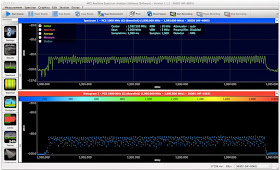This good context for understanding about RSSI and RSRP term. What is the differences?
Below is the explanation of RSSI and RSRP by Andrew J. Shepherd.
by Andrew J. ShepherdBelow is the explanation of RSSI and RSRP by Andrew J. Shepherd.
Sprint 4G Rollout Updates
Monday, July 16, 2012 - 1:40 AM MDT
As Sprint LTE 1900 has become live and discoverable in numerous markets over this past weekend, some of our readers, especially those who are using Android 4.0 ICS based ROMs, have expressed concern at the seemingly low signal levels that they have encountered. For example, see this screenshot from an HTC EVO 4G LTE (under Settings -- About --Network
Note the -102 dBm signal level. If this
were measuring CDMA1X or EV-DO, then, yes, -102 dBm would be nearing the margin of usable signal. But -102 dBm is actually relatively healthy LTE signal level.
To understand why, we need to learn the differences between two types of signal measurement: Received Signal Strength Indicator (RSSI) and Reference Signal Received Power (RSRP).
First, an LTE downlink is divided into subcarriers. A 5 MHz bandwidth downlink, which is the configuration that Sprint is deploying, contains 300 subcarriers. And of those subcarriers, one in three carry LTE reference signals. In other words, of the 300 subcarriers, 100 transmit periodic reference signals.
To illustrate, I captured this power vs frequency sweep with a spectrum analyzer. The LTE downlink graph comes from a Sprint site in the Kansas City area in late April, well before Sprint stopped blocking devices from live LTE sites. So, the sector depicted here exhibits no data traffic; it is transmitting only the periodic reference signals on 100 subcarriers, which you can clearly count in the graph:
To conclude, here are a few takeaways about RSSI and RSRP as signal strength measurement techniques for LTE:
· RSSI varies with LTE downlink bandwidth. For example, even if all other factors were equal, VZW 10 MHz LTE bandwidth RSSI would measure 3 dB greater than would Sprint 5 MHz LTE bandwidth RSSI. But that does not actually translate to stronger signal to the end user.
· RSSI varies with LTE subcarrier activity -- the greater the data transfer activity, the higher the RSSI. But, again, that does not actually translate to stronger signal to the end user.
· RSRP does a better job of measuring signal power from a specific sector while potentially excluding noise and interference from other sectors.
· RSRP levels for usable signal typically range from about -75 dBm close in to an LTE cell site to -120 dBm at the edge of LTE coverage.
Sources: 3GPP




